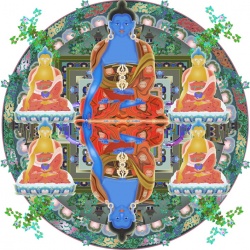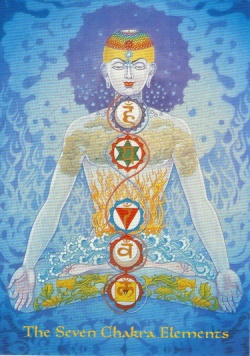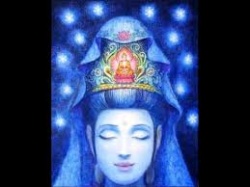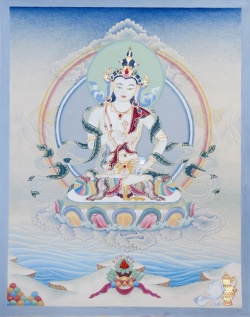The Eleven Virtuous Factors
1. Faith
2. Caution
3. Mental flexibility
4. Equanimity
5. Shame
6. Embarrassment
7. Non attachment
8. Non hatred
9. Non ignorance
10. Non violence
11. Joyful effort
Please listen to the following teaching by generating the altruistic state of mind, bodhicitta.
Sentient beings long for happiness, but are ignorant of the cause of happiness. To create the cause of happiness one needs to know precisely what needs to be abandoned and what needs to be cultivated.
The cultivation of virtue comes from the mind.
The distinction between what is and is not virtuous is made in one’s mind, thoughts and attitudes. This is why we talk about the six root disturbing emotions.
Whenever these six root disturbing emotions arise, one should immediately try to lessen or eliminate them.
The Buddha talked about the virtuous thoughts and acts that should be cultivated, among them, the eleven virtuous mental factors.
It is difficult for someone who is new to meditation to meditate on a view without grasping existence or non-existence. Of the two realities, existence and non-existence, it is better to meditate on the reality of non-existence.
By relying on such meditation, we are able to avert our clinging to existence, which is strongly rooted in our mind.
Meditation on non-existence, that is, meditation on emptiness to counteract the view that holds onto true existence, will gradually lead us to attain the transcendental unfabricated state.
For example, fire can be used to burn garbage. As soon as the garbage has been burned, the fire goes out.
It is not recommended for beginners of meditation to meditate on tögal meditation, the transcendental state that transcends existence and non-existence. One should meditate on non-existence.
If the beginner jumps into tögal, it is questionable whether the practitioner is meditating on the actual transcendental state, most probably the practitioner is fabricating the transcendental state.
We can relate this to the story about a flock of swans flying in the sky.
The king of the swans instructed that when they reached a certain region, they should not make any noise.
The swans passed the message to each other and everybody ended up squeaking, and as a result many swans were caught and killed.
If you were to attempt to meditate on the transcendental state, then your very attempt will create more fabrications and conceptual thoughts.
The actual transcendental state is neither existent, non-existent, both existent and non-existent, and neither existent nor non-existent.
It is beyond these four extremes. Conceiving of this transcendental state is very difficult for beginners because they have so many discursive thoughts. Beginners should study, recognize and understand what discursive thoughts are.
Then they should strive to lessen or abandon them.
Next they should try to recognize and understand the eleven virtuous factors. Having recognized them, they should try cultivating them.
Usually, this is done with a certain amount of attachment, but gradually this practice will lead us to a state free from attachment.
For example, a very small child prefers milk. The small child will not enjoy solid food.
If the small child is fed solid food there is risk. In the same way, if you misperceive what emptiness is, the Buddha said that you will be ruined, not benefited.
The first of the eleven virtuous factors is faith based on trust.
Real trust is based on understanding or wisdom. If your trust is based on examination and analysis, such trust cannot be lost.
Trust that lacks wisdom is not very reliable, because it can be easily changed or lost.
The object of your trust should allow you to lessen or overcome the disturbing emotions, and the mastery of techniques that allow you to cultivate virtuous thoughts and positive emotions.
It is important to understand what we mean by trust or faith, because some forms of trust or faith can be deceptive. You should try to attain the trust that is accompanied by wisdom and understanding.
When you have attained such trust, this can be interpreted as finding refuge. Refuge is a very firm state of mind that is experienced when reversible trust dawns.
Trust is therefore the ground. On the basis of this firm ground of trust, one is able to harvest all kinds of plants.
When you experience a profound sense of trust, it will be very easy for you to have meditative experiences of samadhi.
The second virtuous factor is caution. It is similar to mindfulness or carefulness. Caution can be compared to eyesight.
A person with good eyesight is capable of walking without stumbling.
Whenever your mind is blessed with the virtuous mental factor of caution, your will be able to avoid discursive thoughts, and your mind will not stumble on these emotions.
All beings long for freedom, but it is unwise to give freedom to your discursive thoughts and emotions.
Freedom gives rise to peace and serenity. But if you give freedom to your discursive thoughts and emotions, your mind will not experience peace and serenity.
You should therefore be very conscious of what needs to be abandoned and what needs to be adopted. When we talk about caution, we do not talk about being careful about the objective reality, we talk about being careful with regard to discursive thoughts and emotions.
By practicing caution we attain the third virtuous factor, which is mental flexibility.
Mental flexibility comes with a certain amount of freedom. A literal translation of the Tibetan term is “extremely purified of disturbing emotions.”
If the discursive thoughts and emotions are thoroughly purified and pacified, then the meditator will attain a certain amount of mental power and freedom.
If the meditator wants to release his or her mind, he or she will be able to do so. Likewise, the meditator will be able to control his or her mind if he or she wants to do this. It means a power to have thoughts or not to have thoughts.
Sometimes we don’t like to think, but the thoughts keep intruding. Because of this, the first virtuous factors have a causal relationship.
The attainment of the third mental factor of flexibility is accompanied by supernatural mental powers, like being able to read people’s minds and perform miracles.
The first mental factor comes from wisdom.
The second virtuous factor, caution, comes from meditation. Meditation enables one to stop disturbing emotions and cultivate virtuous and non-discursive thoughts and emotions. This experience of non-discursiveness can be the experience of meditation.
The third virtuous factor comes from the two preceding virtuous factors.
The fourth virtuous factor is equanimity. Equanimity should be understood as bridging the gap of something being superior or inferior,
for example equalizing one’s enemies and friends, existence and non-existence, permanence and impermanence, singularity and plurality, self and others, or purity and impurity.
A mind bridges all these polarities experiences equanimity. This realization is not fabricated.
Because you are recognizing things how they actually are, you are recognizing the suchness of things. The actual reality is equanimity or equality; you are simply uncovering the reality as it is.
Our minds create divisions, but the nature of the objective reality is boundless equanimity. On one earth there are many countries. This is not how the reality is, but we have created divisions, countries and based on these divisions there are disputes and wars.
Ultimately, the world is one, and if our mind were to interpret the objective reality of the world as such, then peace would be the outcome.
But if erasing all the divisions would be a difficult task. It seems impossible to equalize all objective phenomena, but at least the perceiving mind can be made whole.
For this reason the Buddhist master Shantideva says that if you want to protect your feet from being pierced by stones and thorns, it would be an impossible task to cover the whole earth with leather, simply a vast of energy, but if you were to cover your feet with leather soles, the effect would be the same.
If you try to defeat objective enemies, you will strengthen them. If we instead turn within ourselves and try to defeat the enemies within our own mind, then the inner enemies will be weakened.
In this way the mind that entertains polarities, contradictions and divisions should be worked to be made whole and experience the great equanimity.
The fifth virtuous factor is shame. Shame is not generated with regard to external phenomena. It is generated within one’s own being; for example when one generates discursive thoughts and emotions.
The natural state of our minds is great purity, but at the moment our minds do not correspond with that actual nature. When we acknowledge this, we feel shame because we are not in accord with our nature.
If you experience self hate, you should be shameful when you recognize this.
It is also obvious that you trouble yourself when you hate and create pain for others. Whatever creates pain for oneself or others is shameful.
The thought that recognizes the faulty nature of the mind is the actual shame. If you have a nightmare, it is possible to recognize this and to be aware that you are dreaming.
It becomes a lucid dream and you will be liberated.
The sixth virtuous factor is embarrassment. Embarrassment is cultivated on the basis of encountering certain people.
If one refrains from some actions or discursive thoughts out of embarrassment, then this is the sixth virtuous factor.
To practice the sixth virtuous factor, one practices veneration, humility and modesty. The mind that knows embarrassment is not an individualistic mind.
It is not only concerned about itself, but is concerned with the benefit of others.
The seventh virtuous factor is non-attachment.
According to the Hinayana vehicle, non-attachment is the family of the noble, somebody who is completely content. To understand the wholeness of non-attachment, we need to understand what attachment is.
Attachment is a clinging to the objects of the world.
But non-attachment should not be understood in terms of not needing your house, your car, your children, or your family. If you practice non-attachment in this way, you are forsaking sentient beings.
This is not non-attachment; rather, it is non-compassion.
Our compassion should be directed towards external phenomena and reality, and toward other living beings.
Without compassion, sentient beings will simply vanish. Without sentient beings there will be no bodhisattvas or enlightened beings.
This is why the compassionate mind is tremendously powerful.
If you don’t care for an object, the value of that object, regardless of its original value, will be diminished. Even the inanimate objects require our love, which creates a value for that object.
As for sentient beings, needless to say, they need our love and compassion. So the seventh virtuous factor of non-attachment has a very intimate connection with love and compassion.
Non-attachment should be understood in terms of profound contentment. Attachment should be understood as discontentment. If we don’t possess a sense of satisfaction, then we will become miserable.
For this reason, attachment is bad. Whereas when contentment takes root in one’s mind, such a sense of satisfaction is accompanied by happiness.
For example, we may have a very strong attachment to food, but we only have one stomach, and we cannot stuff it with more than it can hold. Similarly, we cannot wear more than one hat. Gluttony can lead to misery.
And if we were to put on every hat that we own, we will be uncomfortableand look ridiculous. Non-attachment should be understood as having the sufficient means for survival, and being satisfied with this without craving more.
Attachment prevents us from practicing generosity. Attachment is symbolized by the preta, the hungry ghosts that are unable to share with others. It is important not to allow the preta to influence our mind.
The eighth virtuous factor is non-hate. To stop violence we have to practice non-hatred. To understand non-hatred we need to understand hatred. Hatred leads to the desire to harm other living beings.
When people harbor a tremendous amount of hatred, then everything in front of them seems disgusting. Due to strong hatred, people have difficulty in associating with others. If they see two persons whispering, immediately they think that they are talking about them.
All this comes about because of hatred. One should eliminate hatred and cultivate the virtuous mental factor of non-hatred.
Non-ignorance is the ninth virtuous factor. To understand non-ignorance properly, we need to understand ignorance. Ignorance is the first root disturbing emotion.
Ignorance is the lack of knowledge of what needs to be cultivated and what needs to be abandoned.
When one’s mind becomes free from ignorance, it becomes filled with wisdom. The Buddha stresses the importance of generating the wise mind, and said that the five paramitas without the sixth paramita, wisdom, is like a person without eyes.
If the five paramitas are supplemented by wisdom, it becomes a complete practice. The first paramita is the practice of giving.
If giving is not accompanied with the practice of wisdom it is not true giving. For example, if you share your ammunition and weapons, you are not being generous.
In brief, whatever gift you make to benefit yourself is not a pure act of giving. For example, if you practice the paramita of giving in order to flourish your religious ideology or dogma, this is not a pure act of giving. You give to another country with the intention of acquiring benefit for your own country.
Or you could practice the act of giving for the benefit of one’s family, or give money in order to gain power.
All these seemingly acts of giving are not pure acts of giving, but what then is a pure act of giving?
A pure act of giving is to give without any expectation, just for the benefit of the receivers. So non-ignorance facilitates wisdom, and wisdom is very important in the act of giving.
The tenth mental factor is non-violence.
If you have taken refuge in the Dharma, this commitment involves non-violence. The root of all Dharma practice is non-violence.
The practice of non violence is as follows: when people inflict violence upon you, you do not retaliate with violence.
If somebody insults, criticizes or strikes you, and you do not retaliate in kind, such a practice is non-violence. The practitioner who can do this is a spiritual warrior.
It is easy to practice non-violence with somebody that treats you kindly, but it poses difficulty to practice non-violence with somebody who is violent towards you. It is also easy to practice non-violence with strangers.
The eleventh virtuous factor is joyous effort. It is connected with the practice of patience in the six paramitas.
Joyous effort assists in the cultivation of all the preceding virtuous factors. A joyous effort focuses on virtuous acts, it does not involve consuming alcoholic beverages or illegal drugs. Joyous effort encourages virtuous acts.
If one makes some kind of perverted effort instead of a joyous effort, then such effort will not be conducive to virtuous thoughts and acts.
In Taiwan there is one very unpopular teacher. One day, the teacher had parked his car in front of the school, his students poured water into the fuel tank of the car.
But if you don’t like what I have been saying, and attempt to put water on the tank of my car, you can’t because I don’t have a car here. Laughter.
It is not necessary to know a lot about the Dharma. It is enough to know the six root disturbing emotions and the eleven virtuous factors. Reducing the six root disturbing emotions and developing the virtuous factors, constitutes the whole practice.
All Buddhist practice can be summed up in three moral trainings: training in moral ethics, training in meditation, and training in wisdom. All of these comprise the practice of abandoning the root disturbing emotions and developing the virtuous factors.
For example, shravakas and the solitary buddhas only meditate on the twelve interdependent links to attain the state of arhathood.
If you practice the eleven virtuous factors and abandon the six root disturbing emotions, this surpasses the 12 interdependent links, and the impact will be all the more powerful.
Life is a highway of impermanence. If you understand the nature of the world as it is, then, even if you have to live within impermanence, that impermanence will not shatter you. You will be able to generate integrity within yourself.
Consider the following story. The Lord of Death and his henchmen were having a meeting because the population of hell was decreasing. One tiger headed henchman said he had a method to bring more people into hell.
If the god realm were emptied, then naturally many of the beings from the god realm would be reborn in the hell realm.
He said, “If we tell the human beings on earth that the god realm does not exist, then the human beings will not practice the ethics that will lead them to rebirth in the higher realms, and they will fall into the lower realm of hell.”
The Lord of Death said, “This seems to be a very good suggestion, but I don’t think it is powerful enough.” Then the ox headed henchman suggested, “If we say that there is no hell realm, than naturally many will do bad things, which will cause them to fall into hell.”
Many similar suggestions and proposals followed, and the Lord of Death agreed with all of them, even though he did not think that any of them were good enough. Then came a low-ranking henchman who claimed to have a special method.
The Lord of Death said, “I don’t think a low ranking henchman like you can have a big idea, but nevertheless, tell us.” The small henchman said, “You should proclaim to the human beings that tomorrow exists.”
Upon hearing this suggestion, the Lord of Death became delighted and said, “This is the most powerful suggestion; it will truly work!” Subsequently, all human beings were told that tomorrow exists, and as a consequence people kept on postponing their practice, procrastinating, and when death came they fell into hell.
Oslo, June 2005
Translated by Lama Changchub at Karma Tashi Ling Buddhist Centre, Norway







